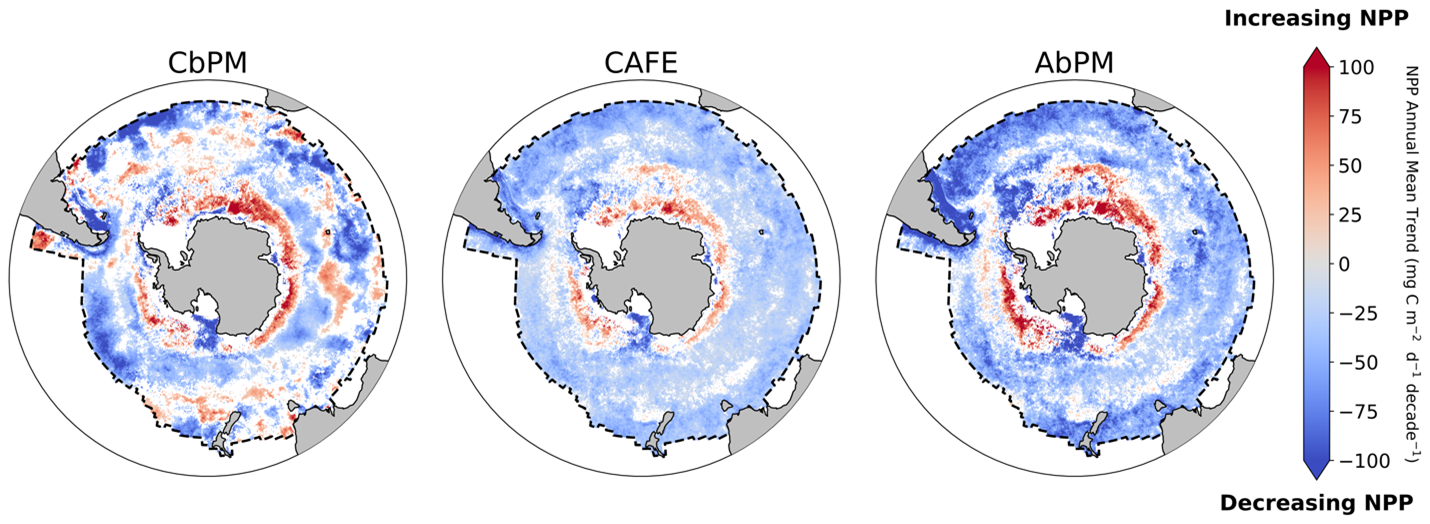CSIR produces a net primary production data product for the ocean climate community
A team of researchers have developed a global oceanic net primary production data product that will help them determine how seasonal characteristics affect productivity in the ocean and how this will modify environmental conditions in the long term. Details about the product were published in the international journal, Earth System Science Data.
A team of researchers have developed a global oceanic net primary production data product that will help them determine how seasonal characteristics affect productivity in the ocean and how this will modify environmental conditions in the long term. Details about the product were published in the international journal, Earth System Science Data.
During photosynthesis, both aquatic and terrestrial plants use some of their newly formed carbon products immediately for energy and maintenance. The remaining photosynthetic products are available for plant growth or consumed by other organisms that eat other plants or animals for energy and nutrients. This available carbon is referred to as net primary production.
Recent studies have found that although net primary production plays a vital role in supporting ecosystem functioning, scientists lack an accurate understanding of whether global net primary production is indeed changing.
In collaboration with researchers from the University of Cape Town’s Marine and Antarctic Research Centre for Innovation and Sustainability and the University of the Witwatersrand’s Global Change Institute, the Council for Scientific and Industrial Research principal researcher, Dr Tommy Ryan-Keogh, used 25 years of ocean colour data ranging from 1998 to 2022 that allows for the use of multiple algorithms, whereby a user can interrogate the distribution of net primary production across different algorithms to identify consensus or outliers that can inform decisions on whether or not to retain or reject specific algorithms in their regional analysis.
“Given the importance of net primary production in assessing carbon budgets, ecosystem health, and environmental change, it is becoming increasingly clear that users require easy access to appropriate data products,” says Ryan-Keogh.
“We took five different commonly used algorithms and applied them to the European Space Agency and Plymouth Marine Laboratory Ocean Colour Climate Change Initiative data to develop one of the longest records available for net primary production,” explains Ryan-Keogh. This multi-model data product provides a range of estimates of global net primary production over a time series of 25 years at both eight-day and monthly resolutions and a spatial coverage of 25 km. The distributions of the models were assessed across 17 different oceanic biomes and long-term observatory sites to highlight either consensus or outliers. The outputs of these algorithms were also assessed for any biases or differences in comparison to the original outputs from single-sensor missions and intra-algorithm differences for the multi-sensor satellite record.
Microscopic marine plants, known as phytoplankton, play an important role in the carbon cycle as they are responsible for approximately 50% of total global net primary production. They also play an important role in oceans by sustaining biodiversity and the transfer of carbon, energy, and nutrients through pelagic and benthic food webs. As such, any changes to the amount of bulk carbon being produced are likely to have an impact on the amount of carbon available for transfer to higher feeding and nutrition levels via the marine food web, with implications for ecosystem health and fishery success. Phytoplankton net primary production is strongly influenced by the physicochemical conditions of the ocean, including light, temperature and nutrient availability. Climate change has already begun to elicit widespread changes to these conditions; for example, increases in temperature and heat content, increased sea ice melt and enhanced precipitation all contribute to alterations of oceanic density and the subsequent nutrient supply into the euphotic zone. Understanding how these climate-driven changes in the physico-chemical environment impact phytoplankton net primary production is critical to addressing one of the most important scientific and policy challenges of the twenty-first century: predicting long-term trends in the ocean-carbon–climate system.
“Being able to provide estimates of change in this key ocean component of the ocean is often hampered by a lack of long-term data. This is why we are pleased to be able to provide this data product, which will be updated on an annual basis, to the wider ocean community so that these important climate-driven questions can begin to be addressed,” says Ryan-Keogh.
The study has been made possible through the support and provision of the computational hours provided by the CSIR-hosted Centre for High-Performance Computing and was funded by the Department of Science and Innovation and the CSIR Parliamentary Grant.




